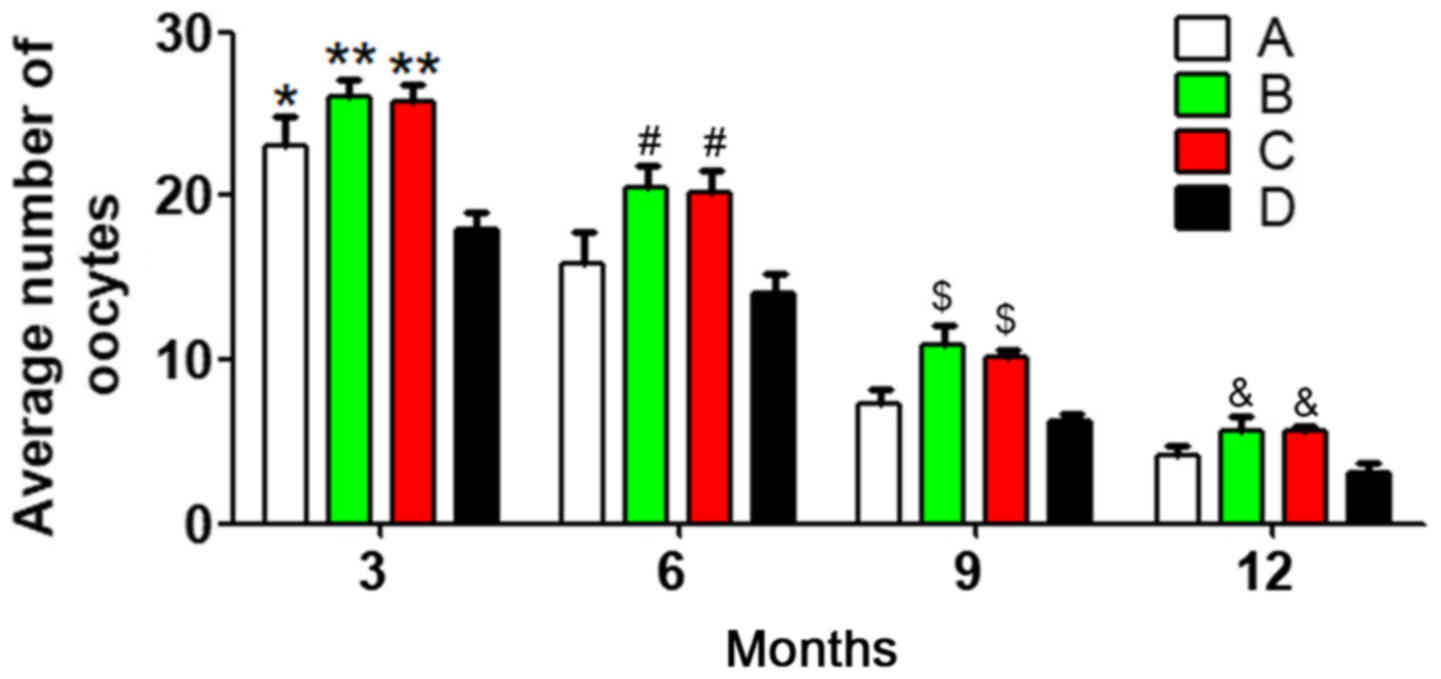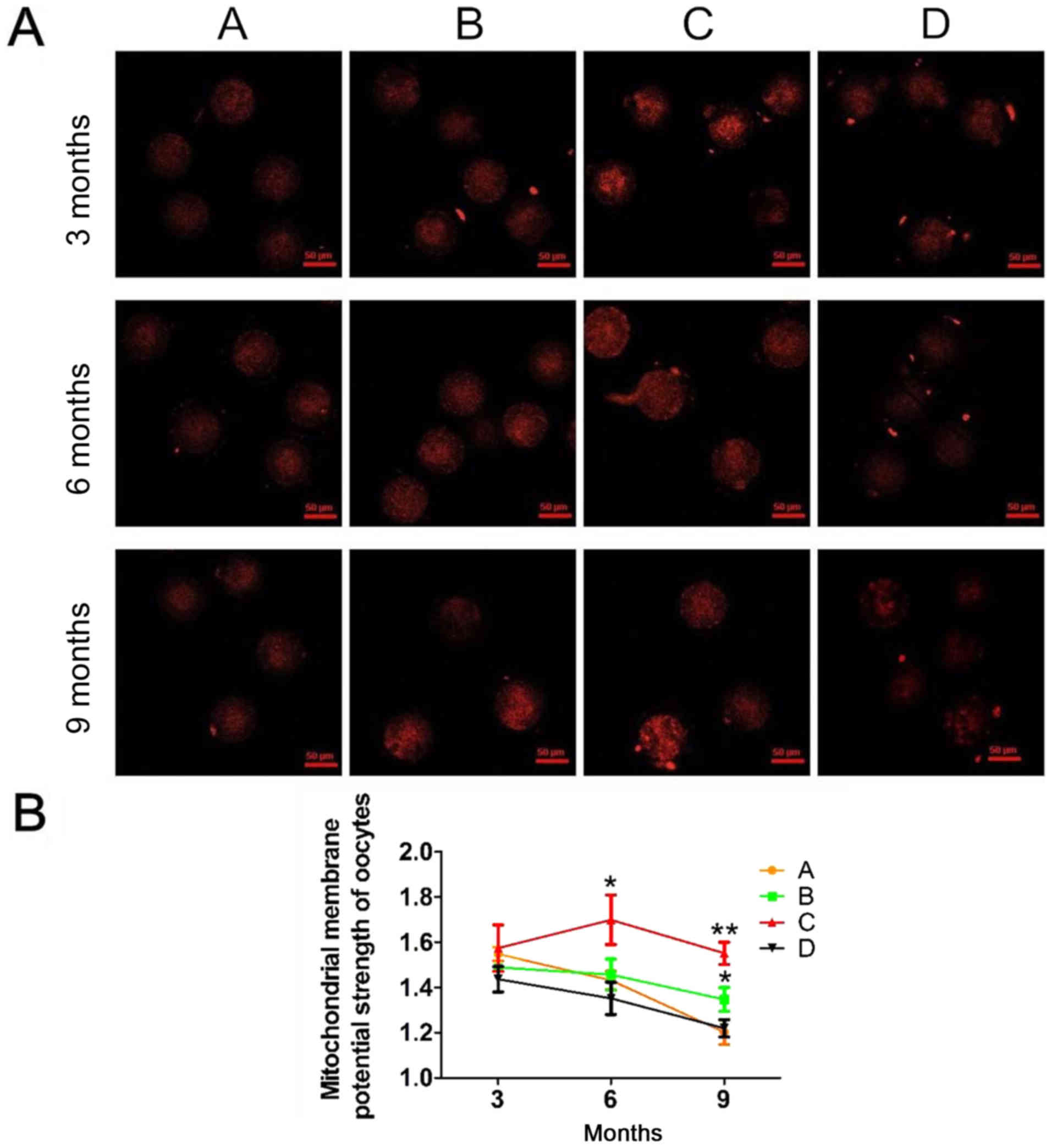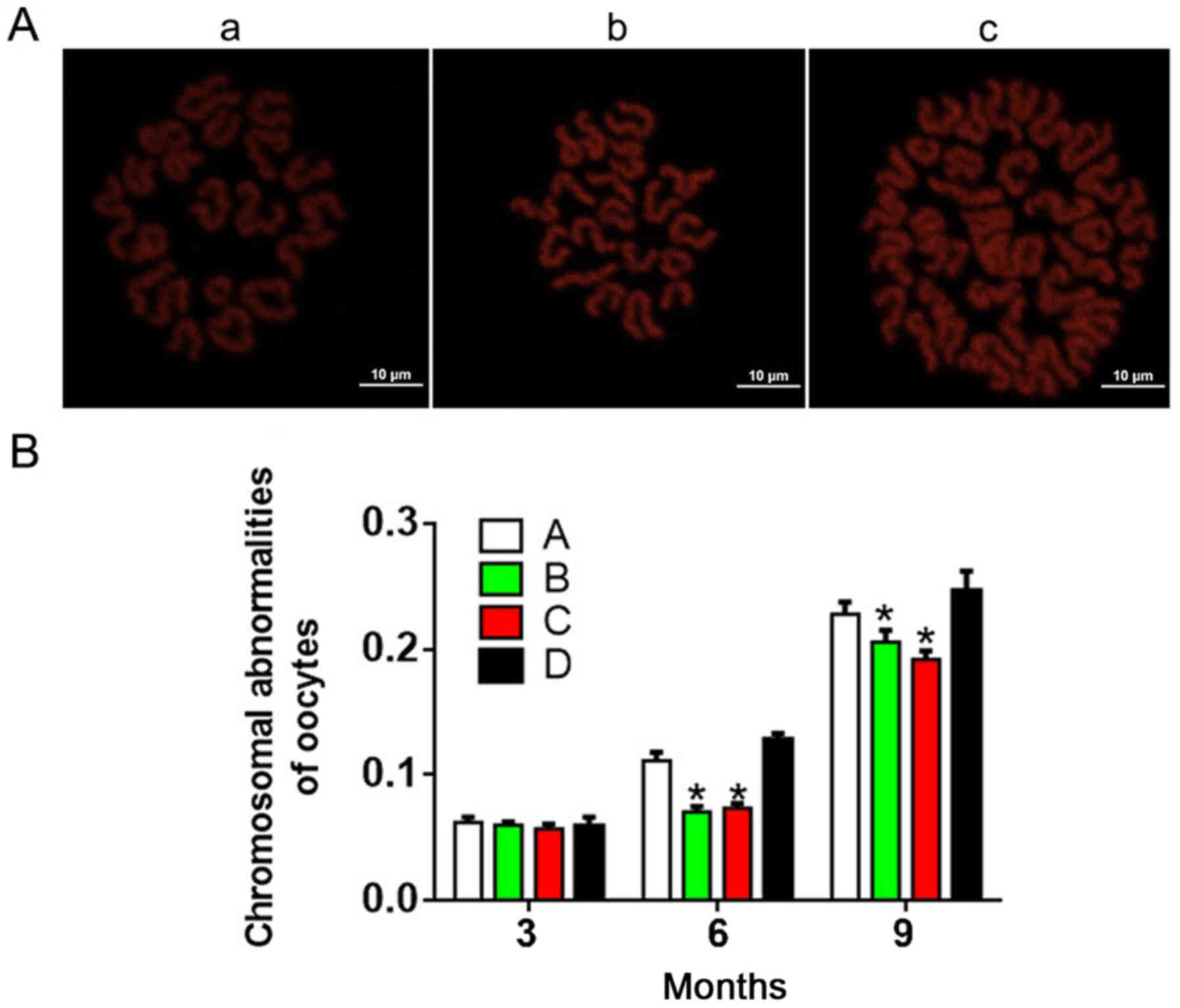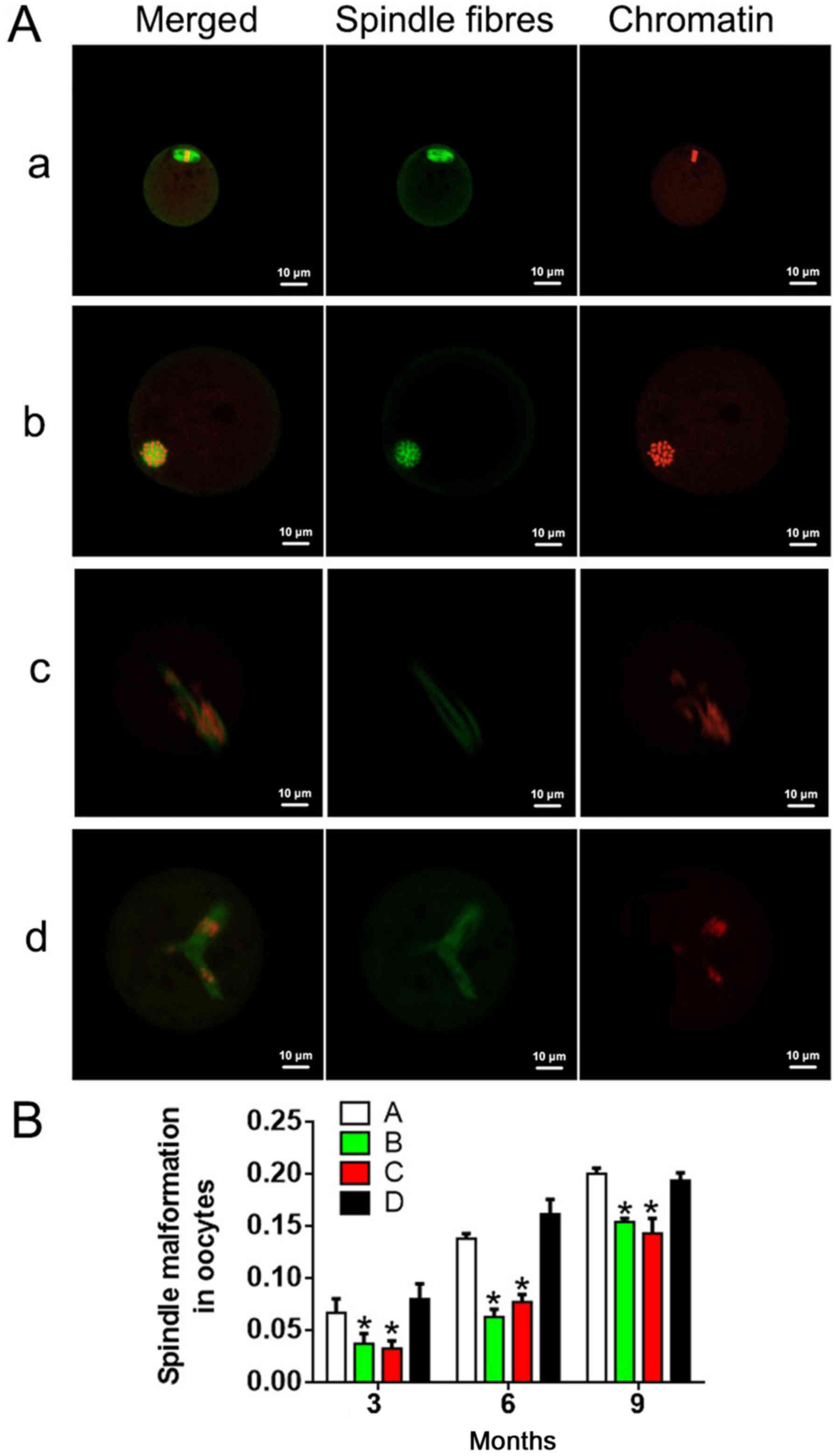|
1
|
Herrera LA, Prada D, Andonegui MA and
Dueñas-González A: The epigenetic origin of aneuploidy. Curr
Genomics. 9:43–50. 2008. View Article : Google Scholar : PubMed/NCBI
|
|
2
|
Dulskiene V and Maroziene L: Impact on
environmental factors on the reproductive system and fetal
development. Medicina (Kaunas). 38:1072–1077. 2002.(In Lithuanian).
PubMed/NCBI
|
|
3
|
Montoya JM, Bernal A and Borrero C:
Diagnostics in assisted human reproduction. Reprod Biomed Online.
5:198–210. 2002. View Article : Google Scholar : PubMed/NCBI
|
|
4
|
Baart EB, Martini E, van den Berg I,
Macklon NS, Galjaard RJ, Fauser BC and Van Opstal D:
Preimplantation genetic screening reveals a high incidence of
aneuploidy and mosaicism in embryos from young women undergoing
IVF. Hum Reprod. 21:223–233. 2006. View Article : Google Scholar : PubMed/NCBI
|
|
5
|
Jones KT: Meiosis in oocytes:
Predisposition to aneuploidy and its increased incidence with age.
Hum Reprod Update. 14:143–158. 2008. View Article : Google Scholar : PubMed/NCBI
|
|
6
|
Chiang T, Schultz RM and Lampson MA:
Meiotic origins of maternal age-related aneuploidy. Biol Reprod.
86:1–7. 2012. View Article : Google Scholar : PubMed/NCBI
|
|
7
|
Zenzes MT: Smoking and reproduction: Gene
damage to human gametes and embryos. Hum Reprod Update. 6:122–131.
2000. View Article : Google Scholar : PubMed/NCBI
|
|
8
|
Kumar S: Occupational exposure associated
with reproductive dysfunction. J Occup Health. 46:1–19. 2004.
View Article : Google Scholar : PubMed/NCBI
|
|
9
|
Gerhard I, Waibel S, Daniel V and
Runnebaum B: Impact of heavy metals on hormonal and immunological
factors in women with repeated miscarriages. Hum Reprod Update.
4:301–309. 1998. View Article : Google Scholar : PubMed/NCBI
|
|
10
|
Tatone C, Amicarelli F, Carbone MC,
Monteleone P, Caserta D, Marci R, Artini PG, Piomboni P and
Focarelli R: Cellular and molecular aspects of ovarian follicle
ageing. Hum Reprod Update. 14:131–142. 2008. View Article : Google Scholar : PubMed/NCBI
|
|
11
|
Coccia ME and Rizzello F: Ovarian reserve.
Ann N Y Acad Sci. 1127:27–30. 2008. View Article : Google Scholar : PubMed/NCBI
|
|
12
|
Tarín JJ: Potential effects of
age-associated oxidative stress on mammalian oocytes/embryos. Mol
Hum Reprod. 2:717–724. 1996. View Article : Google Scholar : PubMed/NCBI
|
|
13
|
Tarín JJ: Aetiology of age-associated
aneuploidy: A mechanism based on the ‘free radical theory of
ageing’. Hum Reprod. 10:1563–1565. 1995. View Article : Google Scholar : PubMed/NCBI
|
|
14
|
Tamura H, Takasaki A, Miwa I, Taniguchi K,
Maekawa R, Asada H, Taketani T, Matsuoka A, Yamagata Y, Shimamura
K, et al: Oxidative stress impairs oocyte quality and melatonin
protects oocytes from free radical damage and improves
fertilization rate. J Pineal Res. 44:280–287. 2008. View Article : Google Scholar : PubMed/NCBI
|
|
15
|
Chaube SK, Prasad PV, Thakur SC and
Shrivastav TG: Hydrogen peroxide modulates meiotic cell cycle and
induces morphological features characteristic of apoptosis in rat
oocytes cultured in vitro. Apoptosis. 10:863–874. 2005. View Article : Google Scholar : PubMed/NCBI
|
|
16
|
Zhang X, Wu XQ, Lu S, Guo YL and Ma X:
Deficit of mitochondria-derived ATP during oxidative stress impairs
mouse MII oocyte spindles. Cell Res. 16:841–850. 2006. View Article : Google Scholar : PubMed/NCBI
|
|
17
|
Tarín JJ, Vendrell FJ, Ten J, Blanes R,
van Blerkom J and Cano A: The oxidizing agent tertiary butyl
hydroperoxide induces disturbances in spindle organization,
c-meiosis, and aneuploidy in mouse oocytes. Mol Hum Reprod.
2:895–901. 1996. View Article : Google Scholar : PubMed/NCBI
|
|
18
|
Liu L and Keefe DL: Ageing-associated
aberration in meiosis of oocytes from senescence-accelerated mice.
Hum Reprod. 17:2678–2685. 2002. View Article : Google Scholar : PubMed/NCBI
|
|
19
|
Choi WJ, Banerjee J, Falcone T, Bena J,
Agarwal A and Sharma RK: Oxidative stress and tumor necrosis
factor-alpha-induced alterations in metaphase II mouse oocyte
spindle structure. Fertil Steril. 88 4 Suppl:S1220–S1231. 2007.
View Article : Google Scholar
|
|
20
|
Tarín JJ, Gómez-Piquer V, Pertusa JF,
Hermenegildo C and Cano A: Association of female aging with
decreased parthenogenetic activation, raised MPF, and MAPKs
activities and reduced levels of glutathione S-transferases
activity and thiols in mouse oocytes. Mol Reprod Dev. 69:402–410.
2004. View Article : Google Scholar : PubMed/NCBI
|
|
21
|
Bhattacharya S, Maheshwari A and Mollison
J: Factors associated with failed treatment: An analysis of 121,744
women embarking on their first IVF cycles. PLoS One. 8:e822492013.
View Article : Google Scholar : PubMed/NCBI
|
|
22
|
Tarín JJ, Pérez-Albalá S and Cano A: Oral
antioxidants counteract the negative effects of female aging on
oocyte quantity and quality in the mouse. Mol Reprod Dev.
61:385–397. 2002. View Article : Google Scholar : PubMed/NCBI
|
|
23
|
Tarín JJ, Vendrell FJ, Ten J and Cano A:
Antioxidant therapy counteracts the disturbing effects of diamide
and maternal ageing on meiotic division and chromosomal segregation
in mouse oocytes. Mol Hum Reprod. 4:281–288. 1998. View Article : Google Scholar : PubMed/NCBI
|
|
24
|
Liu J, Liu M, Ye X, Liu K, Huang J, Wang
L, Ji G, Liu N, Tang X, Baltz JM, et al: Delay in oocyte aging in
mice by the antioxidant N-acetyl-L-cysteine (NAC). Hum Reprod.
27:1411–1420. 2012. View Article : Google Scholar : PubMed/NCBI
|
|
25
|
Harman D: The free radical theory of
aging: Effect of age on serum copper levels. J Gerontol.
20:151–153. 1965. View Article : Google Scholar : PubMed/NCBI
|
|
26
|
Harman D: The biologic clock: The
mitochondria? J Am Geriatr Soc. 20:145–147. 1972. View Article : Google Scholar : PubMed/NCBI
|
|
27
|
Takahashi T, Takahashi E, Igarashi H,
Tezuka N and Kurachi H: Impact of oxidative stress in aged mouse
oocytes on calcium oscillations at fertilization. Mol Reprod Dev.
66:143–152. 2003. View Article : Google Scholar : PubMed/NCBI
|
|
28
|
Liu L, Trimarchi JR and Keefe DL:
Involvement of mitochondria in oxidative stress-induced cell death
in mouse zygotes. Biol Reprod. 62:1745–1753. 2000. View Article : Google Scholar : PubMed/NCBI
|
|
29
|
Zhang D, Keilty D, Zhang ZF and Chian RC:
Mitochondria in oocyte aging: Current understanding. Facts Views
Vis Obgyn. 9:29–38. 2017.PubMed/NCBI
|
|
30
|
Wang WH and Sun QY: Meiotic spindle,
spindle checkpoint and embryonic aneuploidy. Front Biosci.
11:620–636. 2006. View
Article : Google Scholar : PubMed/NCBI
|
|
31
|
Vogt E, Kirsch-Volders M, Parry J and
Eichenlaub-Ritter U: Spindle formation, chromosome segregation and
the spindle checkpoint in mammalian oocytes and susceptibility to
meiotic error. Mutat Res. 651:14–29. 2008. View Article : Google Scholar : PubMed/NCBI
|
|
32
|
Hassold T and Hunt P: To err (meiotically)
is human: The genesis of human aneuploidy. Nat Rev Genet.
2:280–291. 2001. View
Article : Google Scholar : PubMed/NCBI
|
|
33
|
Hassold T, Hall H and Hunt P: The origin
of human aneuploidy: Where we have been, where we are going. Hum
Mol Genet 16 Spec No. 2:R203–R208. 2007. View Article : Google Scholar
|
|
34
|
Djahanbakhch O, Ezzati M and Zosmer A:
Reproductive ageing in women. J Pathol. 211:219–231. 2007.
View Article : Google Scholar : PubMed/NCBI
|


















